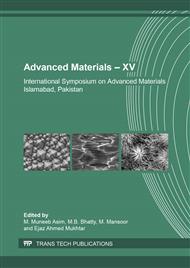p.3
p.9
p.16
p.22
p.28
p.33
p.45
p.53
Tribological Characteristics of Modified Hypo Eutectic Al-Si Alloy
Abstract:
Al-Si eutectic system is a class [Mansoor, 2014 #24] of important cast alloys accounting for the majority of aluminum parts for different industrial applications. However, in unmodified form, it attributes to the lower mechanical strength, ductility and wear characteristics. In present work, Al-9 wt. %Si alloy was prepared in unmodified and modified form, where modification was carried out using mixtures of transitional earth halides. The modification process rectified the needle like silicon rich secondary phase into acicular shape, whose effect upon the tribological characteristic of the alloy were studied using pin-on-disc method. It was found that the coefficient of friction was reduced in modified alloy, besides lowering the wear rate. The main feature of wear scar was laminates. In case of modify alloy the laminates were of uniformly formed small sized, as opposed to non-uniform predominately large sized smooth segments with cracked edges. It was postulated that these non-uniform smooth laminates were formed due to smearing resulted in high coefficient of friction and wear rate. The altered tribological characteristics were attributed to the morphology of the silicon rich secondary phase i.e. the acicular shape.
Info:
Periodical:
Pages:
3-8
Citation:
Online since:
September 2018
Authors:
Permissions:
Share:
Citation:


